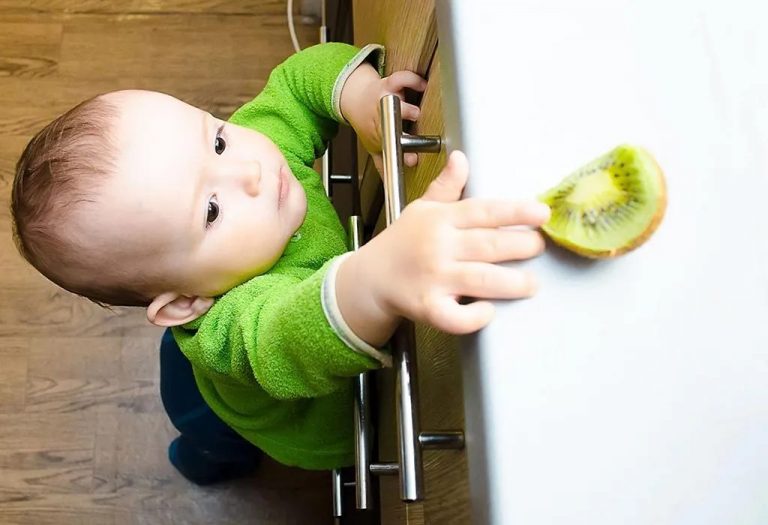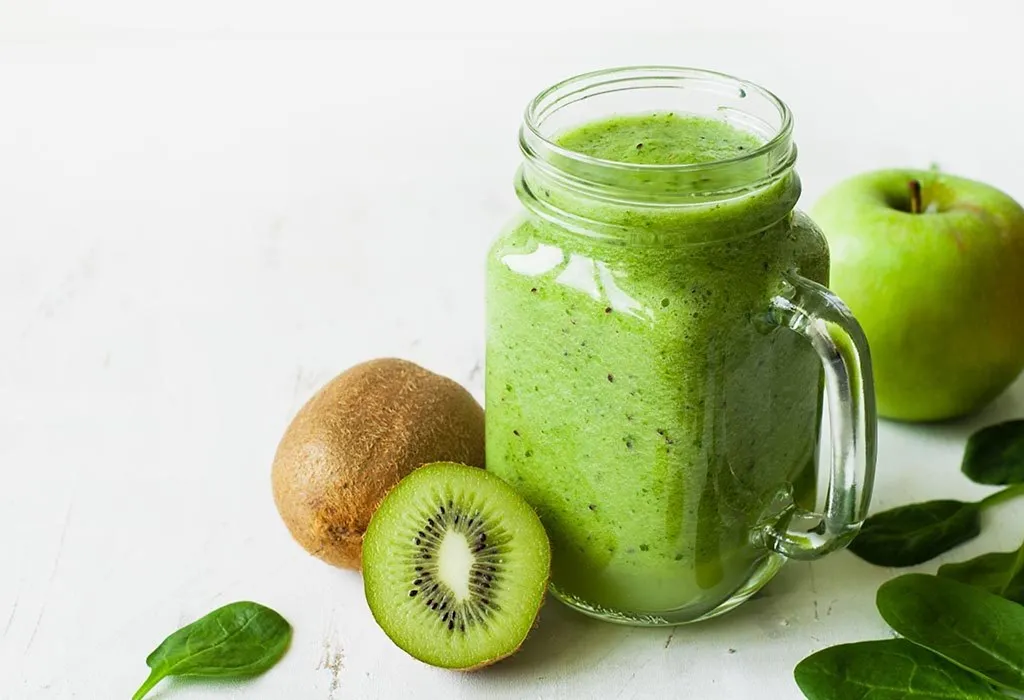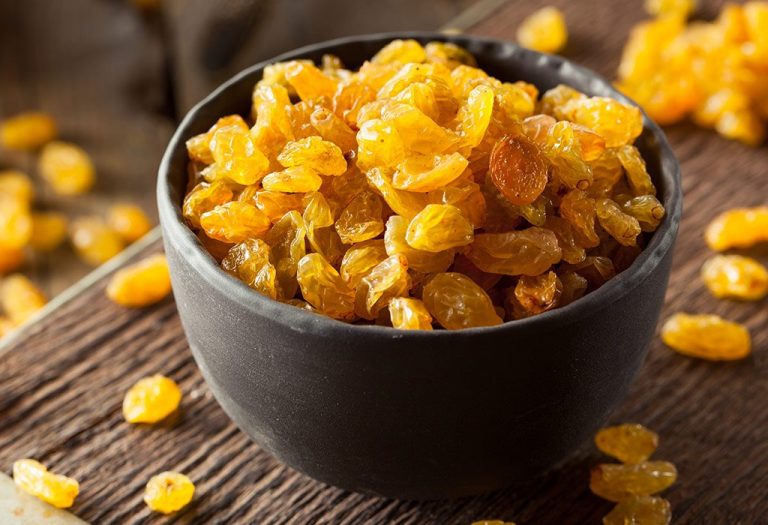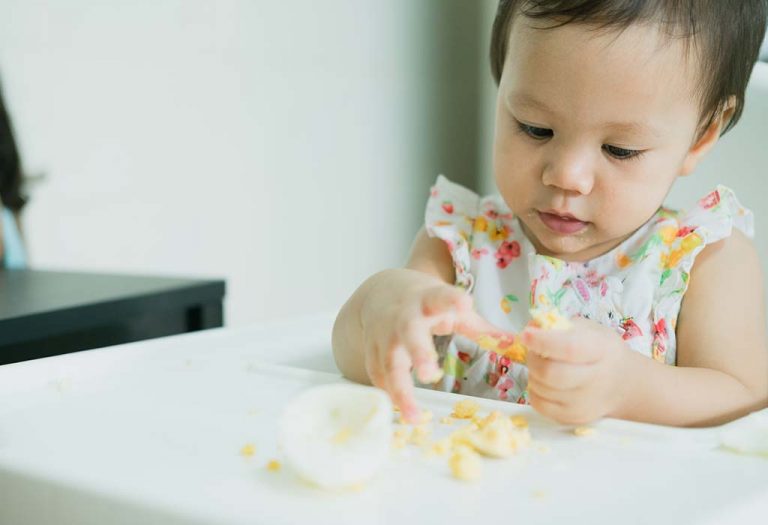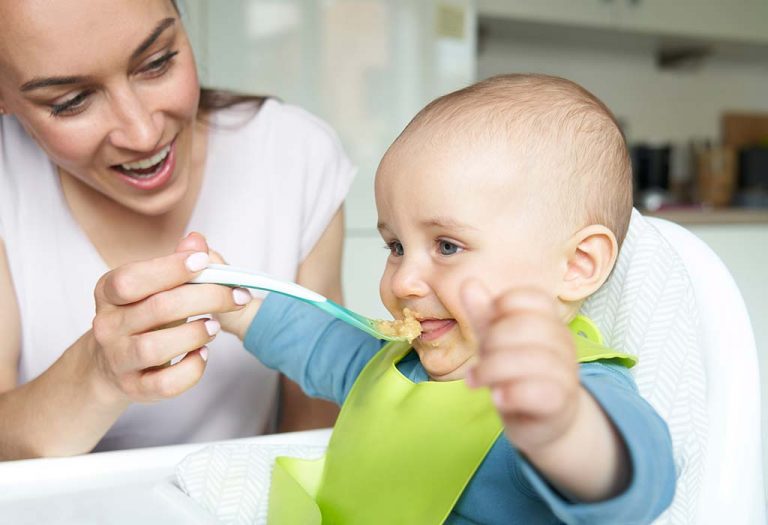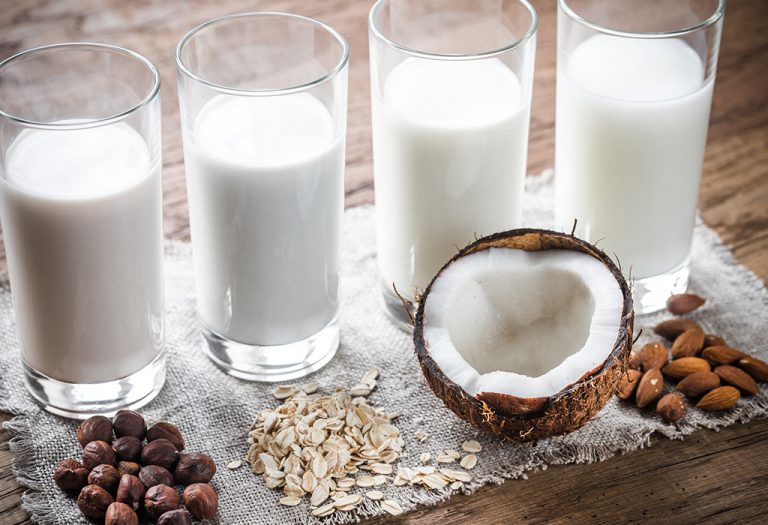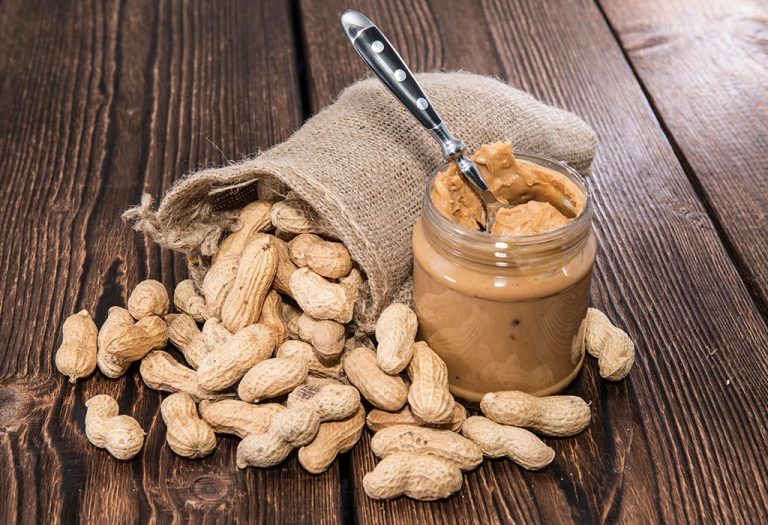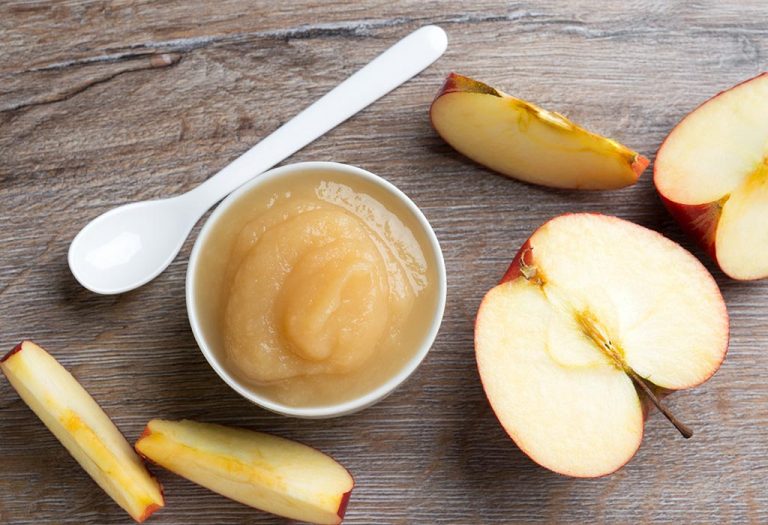Giving Kiwi to Babies – Health Benefits & Recipes

Kiwi or kiwifruit is a fleshy green fruit that is also known as Chinese gooseberry. It has a sweet and tangy taste and provides your baby with a host of health benefits as it is a good source of various vitamins, potassium, and dietary fibre. The fruit is also known to have antioxidants that build immunity, and it is low in calories, too! With these health benefits, many parents would consider feeding the kiwi fruit to their little ones when they introduce them to solids. But, can babies eat kiwi? Is the fruit safe for babies to have? We will find out about the safety of kiwi fruit for infants in this article.
Is Kiwi Safe for Your Baby?
Kiwi is packed with nutrients, but it can be slightly acidic, owing to the vitamin C content in it, and it may give the baby a stomach ache or trigger a loose bowel movement. Having said that, it is safe for babies as it is not a highly allergenic fruit. But, speaking to a paediatrician is highly recommended to prevent health issues. You will find some more information on allergies in the article below.
Once you have confirmed that you baby can have kiwifruit, Getting him used to its sweet-and-sour taste might need some time. Choose ripe kiwis to make a puree as they are sweet and make it easy for your baby to explore the new flavour.
When Is the Right Time to Introduce Kiwi to a Baby?
A kiwi should be introduced between the 8th and the 10th month of the baby’s life. If the baby shows sensitivity such as a diaper rash or tummy trouble, try again after a few months.
The way you introduce new food to your baby will make a difference in how they respond to it. Introduce kiwi when no other new food has been served at the previous meal. Start with a small amount and see how he reacts. Once he shows signs of liking the fruit, add it to the regular meal plan.
So, how does Kiwi benefit your child’s health? Read on to know its nutritional value and health benefits.
Nutritional Value of Kiwi
This superfruit is packed with vital nutrients such as vitamins K, C and E, potassium, folate, dietary fibre, copper, choline, magnesium and phosphorous.
Nutrients Present in 100 Grams of Kiwi Fruit
| Constituent | Quantity |
| Carbohydrate | 14.7 g |
| Protein | 1.1 g |
| Fat | 0.5 g |
| Fibre | 3 g |
| Water | 83.1 g |
| Vitamin A | 0.26 mg |
| Vitamin C | 92.7 mg |
| Vitamin E | 1.5 mg |
| Vitamin K | 40.3 ug |
| Niacin | 0.3 mg |
| Vitamin B6 | 0.1 mg |
| Folate | 25 ug |
| Calcium | 34 mg |
| Iron | 0.3 mg |
| Magnesium | 17 mg |
| Phosphorous | 34 mg |
| Potassium | 312 mg |
| Sodium | 3 mg |
Benefits of Kiwi Fruit for Your Baby
Kiwis offer a host of benefits for babies, children and adults. Introducing them to the baby will help build immunity. Here are some more health benefits the fruit offers.
- Being high in fibre, it is helpful in relieving constipation.
- It is a rich source of disease-fighting antioxidants and builds immunity.
- High in vitamin C, it helps boost the immune system.
- It increases iron absorption from other foods.
- It is rich in phytonutrients; it helps repair DNA and protects against a few types of cancer.
- Adding kiwi can prevent asthma, high blood pressure, kidney stones, and obesity. It can lower fat in the blood and reduce blood clot risks at later stages in life.
- The fruit promotes healthy skin.
- It induces better sleep, allowing the body to rest well and aids proper growth and development.
Parents have to be careful about what they feed their babies. So, when you think about introducing kiwifruit into your little one’s diet, you need to know when you must avoid it. Read below to know more.
When to Avoid Kiwi Fruit for Your Baby?
Kiwi does not trigger allergies; however, it is acidic in nature. The acidity of the fruit may prompt mouth or diaper rashes. If your baby shows sensitivities like tummy troubles, rashes or spits the mashed fruit out when you first introduce it to him, try again after a few months. If your baby has acid reflux, wait for a year before adding kiwi to his diet.
Allergy to kiwi is uncommon. However, babies with hay fever (allergic rhinitis) need to stay away from it as it may cause skin irritations around the baby’s mouth. This is common but not harmful.
Indications of allergies towards kiwi include a sore mouth, itching of throat or swelling of the tongue, mouth, lips and face. It may induce vomiting at times. Severe allergies include wheezing or breathing difficulties that might require immediate medical attention. It is important to know which food has triggered the allergic reaction, so introduce one new food at a time and do not mix it with other foods. Start with feeding little amounts; if the baby is not showing any allergies, increase the quantity.
Allergic reactions to kiwi fruit tend to be linked with birch pollen allergies, cedar allergies or latex allergies. Hence, if your baby is allergic to papaya, pineapple, sesame seeds, celery, honey, peach, apple, bananas, avocado, cherry, plum, or pear, then he may be allergic to kiwis as well.
Once allergies are ruled out and your baby seems to like the taste of ripe kiwis, you may add the recipes given below to add variety into your baby’s diet.
Are Kiwi Often Considered a Choking Hazard for Babies?
Yes, kiwi fruit can be considered a choking hazard for babies and young children, especially if not prepared properly. The seeds and the texture of the fruit can pose a risk if a piece is not properly mashed or cut into small, manageable pieces. It’s generally recommended to avoid giving whole kiwi fruit to babies and instead to serve it in a way that minimizes the risk of choking, such as pureeing or cutting it into very small, soft pieces. Additionally, always supervise infants and young children when they are eating to reduce the risk of choking on any food.
Quick Kiwi Recipes for Babies
Kiwi can be fed in many interesting ways; you can make fruit cocktails, smoothies, salads, dips, desserts, popsicles, kiwi puree for baby, or simply dice the fruit and serve it. Choose the right way to suit your baby’s age or feel free to modify them to make it appetising for your little one.
1. Fresh Tropical Fruit Cocktail
Ingredients
- Kiwifruit – 1, ripe
- Mango – 1/2, diced
- Pineapple chunks – 1/2 cup
- Strawberries – 2 to 3
- Water – 1/2 cup
Method
- Wash the fruits, peel, and chop them.
- Blend the fruits in a food processor.
- Add some water to dilute the cocktail for infants.
2. Kiwi Smoothie
Ingredients
- Spinach leaves – 1/2 cup
- Kiwi – 1, ripe
- Apple/Pear – 1/2, diced/sliced
- Water – to dilute (optional)
Method
- Blanch the spinach.
- Peel and chop the fruits.
- Blend the fruits and the spinach together in a food processor.
- You may dilute this recipe also with some water.
3. Fruity Dips
Ingredients
- Kiwifruit – 1, small ripe fruit
- Peach – 1/2, ripe
- Cottage cheese – 2 tbsp
Method
- Peel and mash the kiwi and peach. Crumble cottage cheese, and mix to a smooth consistency.
- Serve the dip with whole-wheat toast, or use it as spread on bread or sandwich filling.
4. Fruit Yoghurt
Ingredients
- Kiwifruit – 1, ripe
- Banana – 1, ripe
- Pear – 1/2
- Crushed cereals – 2 tbsp
- Thick homemade yoghurt – 1 cup
Method
- Peel and chop the fruits.
- Add crushed cereals and blend with yoghurt.
- Serve it at room temperature or chilled.
5. Kiwi Popsicle
Simply peel the kiwi and slice it with an egg-slicer. Freeze it to be served with a drizzle of honey as a dessert or turn them into popsicles. It is a great way to beat the summer heat or soothe inflamed gums during teething.
Ingredients
- Ripe banana – 1 large
- Ripe kiwifruit – 1
- Yoghurt – 1 cup
Method
- Peel and roughly chop the kiwi and banana.
- Blend with yoghurt in a food processor.
- Pour it in popsicle moulds and freeze until firm.
- Drizzle a small amount of honey on top for an extra sweet treat!
6. Kiwi Salad
This recipe is apt for kids who have been introduced to all the ingredients given below and are old enough to chew them and not choke on them. For older kids, you may choose to drizzle some dressing too.
Ingredients
- Kiwifruit – 1, diced
- Apple – 1, diced
- Cranberries – 1/4th cup (optional)
- Walnuts – 1 to 2 tbsp (optional)
- Feta cheese – 1 to 2 tbsp, crumbled
- Spinach Leaves – 7 to 8
Method
- Mix all the fruits together.
- Add the walnuts and feta cheese.
- Serve on a bed of spinach.
- Drizzle a dressing of your choice (optional).
7. Kiwi Puree
Ingredients
- Kiwis – 4, ripe
- Diced Apples or Grape Juice – 1/2 cup
Method
- Peel and cut the kiwis.
- Add juice in a medium-sized pot and boil till the kiwis are soft.
- Then, turn off the heat and mash or puree it.
- Serve with a spoon or in a feeder.
8. Kiwi Banana Mash
Ingredients
- Kiwifruit – 1, ripe
- Banana – 1, ripe
- Breast milk or formula (optional)
Method
- Peel and chop the kiwifruit and banana into small pieces.
- Steam or boil the fruits until they are soft and tender.
- Mash the fruits together using a fork or potato masher.
- For a smoother consistency, blend the mashed fruits with a little breast milk or formula.
- Allow the mash to cool before serving to your baby.
9. Kiwi Avocado Smash
Ingredients
- Kiwifruit – 1, ripe
- Avocado – 1/2, ripe
- Baby rice cereal or quinoa flakes – 2 tablespoons (optional)
- Lemon juice – 1 teaspoon (to prevent oxidation)
Method
- Peel and chop the kiwifruit and avocado into small, manageable pieces.
- Mash the kiwifruit and avocado together in a bowl using a fork.
- If desired, add baby rice cereal or quinoa flakes to enhance the texture and nutritional content.
- Add lemon juice to prevent the mixture from turning brown due to oxidation.
- Mix well until you achieve a suitable consistency for your baby.
- Serve this nutritious smash as a tasty and healthy snack for your little one.
You can reduce the acidic nature of kiwi by combining it with bananas, avocados, ripe mangoes, applesauce or pears and make interesting baby food. It will also help to develop taste in babies.
If you still have some more concerns regarding feeding kiwis to your little one, you may want to read through the FAQs.
How to Prepare Kiwi for Baby-Led Weaning?
Introducing kiwi in baby-led weaning can be a fun and nutritious experience. Kiwi is rich in vitamin C, fiber, and antioxidants, making it a great addition to your baby’s diet. However, it’s important to prepare it in a way that is safe and appropriate for your baby’s age and developmental stage.
For 6+ Month Old
- Peel the kiwi and cut it into large wedges or slices, making sure they are easy for your baby to grasp.
- You can also steam or bake the kiwi wedges until they are soft and offer them to your baby as finger foods.
- Supervise your baby closely to ensure they can handle the texture and are not at risk of choking.
For 9+ Months
- Continue offering peeled and sliced kiwi to your baby, but you can now cut the slices into smaller, bite-sized pieces.
- You can also mash or puree the kiwi and mix it with other soft fruits or yogurt for added flavor and nutrients.
- Encourage self-feeding and exploration with different textures.
For 12+ Months
- By this age, your baby should be able to handle diced or chopped kiwi without any issues.
- Offer kiwi alongside other foods as part of balanced meals and snacks.
- Continue to encourage independence and variety in your baby’s diet, incorporating kiwi in creative ways such as in smoothies or mixed with oatmeal.
FAQs
Here are some commonly asked questions about feeding kiwis to babies
1. How should I choose kiwis for my baby?
Choosing organic fruits is always good. However, kiwis do not get contaminated due to pesticides. To know if the kiwis are sweet and ripe, hold them one by one between your thumb and forefinger and gently press them. Pick the ones that are firm and feed them only when they ripen. Do not pick the ones with bruised skin, or visible indentations. Also, avoid the ones that are shrivelled, squashy, soft, or have damp spots. Unripe kiwis can be placed in a paper bag with a banana, apple or pear to ripen them within two days. Kiwis can be stored for three to four weeks when refrigerated or up to a week at room temperature.
2. Should I peel the kiwi before serving it to my baby?
Wondering how to serve kiwi to baby? You should peel the skin before serving it to your baby as it will be difficult for him to chew and could choke on it. Once the kid is old enough to chew the skin, remove the hairy surface by scrubbing lightly with a clean towel and serve as preferred.
You can peel the kiwis by slicing off each end of the fruit and removing the skin lengthwise with a sharp knife. Alternately, remove both ends and then insert a thin teaspoon just between the flesh and the skin, twist it all the way around the outer edge of the fruit to effectively remove the skin. Or, you may simply cut the fruit in half and feed the inner pulp/flesh to the baby with a spoon.
3. Can I give kiwi seeds to my baby?
You do not have to remove the seeds from the fruit. They are very tiny and do not pose a choking hazard. Do not panic, though, when you see them in your baby’s diaper as they are not usually digested.
4. Can my baby be allergic to kiwi?
Yes, some babies may have allergies to kiwi, although it’s not as common as allergies to other fruits. If there is a family history of food allergies or if your baby has shown signs of allergies to other fruits, it’s advisable to introduce kiwi cautiously and watch for any adverse reactions such as rash, itching, swelling, or difficulty breathing. If you suspect an allergic reaction, seek medical attention promptly.
This was all about how to cut kiwi for baby and how to serve. When it’s time for your baby to start with solid foods, start slow and incorporate most foods that are healthy for your baby. When the time is right, you may introduce Kiwis too. The fruit serves as a good option to be given to your baby as it’s loaded with nutritional benefits and tastes good too. Having said that, it is highly recommended that you speak to your paediatrician before starting any food for your baby.
References/Resources:
1. Lucas. J, Grimshaw. K, Collins. K, Warner. J, Hourihane. J; Kiwi fruit is a significant allergen and is associated with differing patterns of reactivity in children and adults (Clinical & Experimental Allergy); National Library of Medicine; https://pubmed.ncbi.nlm.nih.gov/15248859/; July 2004
2. Feeding Your Baby 6 months to 1 year; Healthy Child Manitoba; https://www.gov.mb.ca/healthychild/healthybaby/hb_solidfoods.pdf
3. Richardson. D, Ansell. J, Drummond. L; The nutritional and health attributes of kiwifruit: a review (European Journal of Nutrition); National Library of Medicine; https://www.ncbi.nlm.nih.gov/pmc/articles/PMC6267416/; February 2018
4. Starting Solid Foods; American Academy of Pediatrics; https://www.healthychildren.org/English/ages-stages/baby/feeding-nutrition/Pages/Starting-Solid-Foods.aspx#
5. 6 Health Benefits of Kiwifruit; Cleveland Clinic; https://health.clevelandclinic.org/kiwi-benefits/
6. Feeding your baby: 6–12 months; UNICEF; https://www.unicef.org/parenting/food-nutrition/feeding-your-baby-6-12-months
7. Kiwi; Solid Starts; https://solidstarts.com/foods/kiwi/
Also Read:
Mango for Infants
Chikoo (Sapota) for Babies
Are Bananas Good for Infants
Introducing Grapes to Babies
Was This Article Helpful?
Parenting is a huge responsibility, for you as a caregiver, but also for us as a parenting content platform. We understand that and take our responsibility of creating credible content seriously. FirstCry Parenting articles are written and published only after extensive research using factually sound references to deliver quality content that is accurate, validated by experts, and completely reliable. To understand how we go about creating content that is credible, read our editorial policy here.






